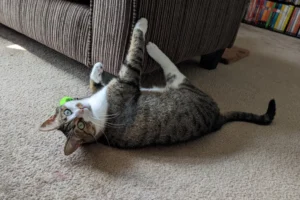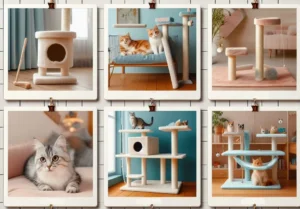Cat claws are more than just a cute accessory – they serve a vital purpose in a feline’s life. But why are cat claws important? Let’s delve into the reasons behind this crucial feline feature.
Provides Balance and Stability
Cat claws are not just for scratching furniture or chasing toys; they play a crucial role in helping cats maintain balance and stability. Imagine your furry friend gracefully navigating tricky terrain or effortlessly climbing to high places – their claws are what make these impressive feats possible.
Cats have a remarkable ability to balance on narrow structures like fences or tree branches, thanks to their claws gripping onto surfaces. This natural adaptation allows them to explore their environment with confidence and agility, showcasing their acrobatic skills with ease.
Additionally, when cats engage in activities like running, jumping, or pouncing, their claws provide traction and support, keeping them steady and preventing slips or falls. So, the next time you see your cat effortlessly leaping from one surface to another, remember – it’s their claws that are silently working behind the scenes to ensure a safe landing.
In essence, cat claws are not just a cosmetic feature; they are a fundamental part of a cat’s anatomy that enables them to move with grace and precision, enhancing their overall quality of life. So next time you marvel at your cat’s incredible balance and agility, give credit to their trusty claws for making it all possible.
Self-Defense Mechanism
Cat claws are not just sharp tools for scratching; they serve as a vital self-defense mechanism for our feline friends. In the wild, cats rely on their claws to protect themselves from potential threats, whether it’s defending their territory from intruders or warding off predators.
When faced with danger, cats instinctively deploy their claws as a means of defense, showcasing their impressive arsenal of natural weapons. Whether it’s swatting at an opponent, delivering a warning swipe, or fleeing from a dangerous situation, their claws are essential for survival in the wild.
In addition to physical defense, cat claws also play a role in communication, as cats use them to signal their mood or establish boundaries with other animals. So, the next time you see your cat extending their claws during play or interaction, remember that it’s not just a display of sharpness—it’s a form of non-verbal communication that is integral to their social behavior.
It’s essential to respect and understand the significance of cat claws, recognizing them as a multifunctional tool that goes beyond just grooming or scratching. By appreciating their role in self-defense and communication, we can develop a deeper bond with our feline companions and ensure their well-being in our shared environment.
Climbing and Exploration Abilities
Cat claws play a crucial role in helping our feline friends navigate their environment with ease. These sharp tools enable cats to climb trees effortlessly, explore every nook and cranny of their surroundings, and engage in physical activities that are vital for their overall well-being. Without claws, cats would struggle to climb, jump, or even defend themselves. So, the next time you see your cat effortlessly scaling a tree or gracefully leaping from one surface to another, remember that their claws are their secret weapon in conquering the world around them.
Grooming and Hygiene
Cats are well-known for their impeccable grooming habits, and their claws are a key part of this routine. Cats use their claws not only for scratching and stretching but also for grooming purposes. By licking their claws and using them to comb through their fur, cats can effectively remove dirt, debris, and loose hair, keeping themselves clean and healthy. So, the next time you see your cat meticulously grooming themselves, remember that their claws are essential tools in maintaining their hygiene and well-being.
Additional Unique Insight:
- Cats’ claws also play a role in marking their territory through scent glands located in their paw pads. When cats scratch surfaces with their claws, they release pheromones that help them communicate with other cats in the area. This behavior helps them establish their territory and communicate with their fellow felines.
Communication Tool
Cat claws are not just for scratching furniture; they serve as a vital tool for communication. When a cat kneads on your lap or scratches at a designated spot, they are not just sharpening their claws; they are marking their territory with scent glands located in their paws. This behavior helps them establish their presence and comfort in their environment. Additionally, cats use their claws to communicate with other felines, leaving behind visual and scent markers that convey information about their age, health, and reproductive status. So, next time your furry friend kneads on you, know that they are expressing their affection and marking you as their own.
Hunting and Survival Instincts
Cat claws are crucial for a cat’s hunting and survival instincts. These retractable tools are more than just weapons; they are essential for capturing prey and defending themselves against potential threats. Cats rely on their claws to climb trees, catch birds, and move swiftly to outmaneuver prey. In fact, domestic cats retain the hunting instincts of their wild ancestors, and without their claws, they would struggle to perform these natural behaviors. So, the next time your cat presents you with a “gift” of a bird or mouse, remember that their claws played a significant role in their successful hunt.
- Cats use their claws to grab and hold onto prey, ensuring a successful catch.
- Climbing trees is made possible by their sharp claws, allowing cats to escape predators and survey their surroundings.
- Scratching provides cats with a form of exercise to keep their claws healthy and strong.
Remember, regular claw maintenance, like scratching posts and nail trims, is essential for keeping your feline friend happy and healthy.
Nail Health and Maintenance
Taking care of your cat’s claws is crucial for their overall well-being. Regularly trimming your cat’s nails can prevent overgrowth, which can lead to discomfort and potential health issues. To properly trim your cat’s claws, use a specialized pet nail trimmer and be cautious not to cut the quick, which is the sensitive inner part of the nail. If you’re unsure about how to trim your cat’s claws, consult your veterinarian for guidance.
In addition to trimming, providing your cat with a scratching post is essential for maintaining healthy claws. Scratching posts allow cats to engage in natural behaviors like scratching and stretching while also helping to shed old nail sheaths. Place the scratching post in a central location in your home where your cat likes to scratch, encouraging them to use it regularly. By incorporating regular nail care and scratching posts into your cat’s routine, you can help ensure their claws stay healthy and strong.
Extra Tip: Regularly check your cat’s claws for any signs of overgrowth or irritation, and consult your veterinarian if you notice any issues to prevent further complications.
Fun Facts About Cat Claws
Cat claws are not just tools for scratching and climbing; they also play a vital role in a cat’s communication and well-being. Did you know that cats have a specialized layer of tissue called the ‘stratum corneum’ that covers their claws, allowing them to retract and extend them as needed? This adaptation helps keep their claws sharp and protected when not in use.
Another interesting fact is that cats use their claws for marking territory through scent glands located between their paw pads. When they scratch on surfaces, they leave behind both visual and olfactory signals, communicating with other cats in the area. This behavior is a natural instinct for cats and helps them establish boundaries and communicate with their environment.
Extra Tip: Providing your cat with a variety of textures and materials for scratching can help satisfy their natural instincts and prevent them from damaging furniture or carpets in your home.
Alex, a passionate animal lover, has experience in training and understanding animal behavior. As a proud pet parent to two dogs and three cats, he founded AnimalReport.net to share insights from animal experts and expand his knowledge of the animal kingdom.









